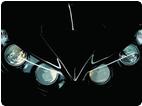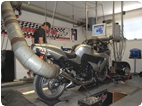Lettuce put it this way, Trav, sounds like big bucks. No more starting. Whipping the engine up is a rod about to kick out the case. Tell the service writer to drop the sump to inspect rather than hear the engine. That one last rev by the tech and it blows out the case, make sure you said to not start it or they eat the cases and a lot more parts it takes out. Have them sign it on their own work order they wrote you up with>> you told them so. They need to know just to save both [of you] a lot of grief.
Here's the scenario for low oil level:
1. Low oil is not at splash lubing height.
a. That's splash under the piston and onto the cylinder walls to lube/cool.
b. There is some ticking and when the piston changes direction, the piston can slap if the tolerance is not in place. So a tick-tick is one variable of lost clearances due to galling and snowballs the metal off the part, causes material to drop to the bottom.
c. The timing chain needs lubing and the chain slipper guide to keep the slapping happening from lifts off the throttle. That rattle of the chain sounds like?
d. The top end is last to be lubed and the head has the most heat to be cooled. As little as that oil was receiving, in other words, the pump is waiting for that oil to come back down, it may have gone dry.
Here is the 'lost my power' scenario:
2. Once a noise is heard...
a. Never start it again but tear it down to inspect.
b. The galling has happened, nothing smooth is moving over parts. Note the galling and the expansion of clearances begin to make noise.
c. Continued running is that the clearance is gone, no pressure to hold oil from moving slower and not pickup heat to move away from the parts.
d. The galling continues and the noise becomes louder. There is this spinning/churning/crunching/powdered down parts laying in the sump pan. The powder gets sucked up the oil pump, crushes those powdered parts, imbeds into the pump blades, sends that material throughout the engine and that means oiled powder in the transmission gears and bearings.
e. The ticking noise up top? I'm going to guess your top end is the last to be lubed, spins twice as opposed to the crank turning once. The galling took out the cam caps and saddles, the valve opens and this now pushes the cam up the galled caps, the valve does not open wide like it once did. The power increases, the loud top end ticking becomes louder as you rode home, etc.
Possible engine damage?
Pistons: That powder contamination and the mixing there of with the oil. The 2qt splash is now mixed with that worn powder, the splash has some powder mixed, the scratching of the cylinder walls gouge out the finish and piston's finish.
Rings: Possible rings being cut with lines. Add the lines up in the ring and there is a leak past the rings. More loss of power.
Head: The last to be lubed is the head. The ticking top end would sound like a wiped head, the cam floating, the buckets tapping noise is that float way out of tolerance.
Cam: Rub two hands together, which stayed cold? So with two metals meeting each other dry, they gall the softer metal and the lines in the harder material cannot be machined away without losing that preset tolerance from that core cam.
Crank: Again, what got sucked up the pump and now is spit out of a lube hole, the contaminants wipe the bearing, the line made in the crank's smooth finish, that galling or snowballing of that one cut around the crank, starts in on the next 360 degrees and eats more on the next gouge and the next 360 degrees gouges more out and so on.
Rods: The connecting rods float on the crank and slap to the sides of the crank. If this is galled as the contaminants are pushed out the crank insert, this spinning on the thrust sides will gall that thrust and now the rods are galled at that area as is the crank. One might inspect that area. But if you sand that clearance down on the rod, the rod is now narrower and the thrust is going to slam into the thrust side, not fluff into the side with less clearance to soften the blow. Add cleaning the crank's thrust area and you now drive a semi thru the gaps.
Inserts: The crank has to be inspected to see IF those inserts were damaged. If say they drop the pan, push each rod big end, one will move and that says junk crank/inserts/rods/etc. So technically, I pull the valve cover for top end damage and drop the pan for powered material... I do not need to hear the engine having those top and bottom end covers showing the way.
* Last updated by: Hub on 2/4/2015 @ 9:14 AM *
Tormenting the motorcycling community one post at a time









